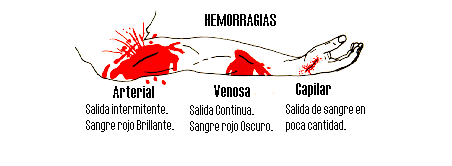
Etor IRAOLA
Formación |
Este post tiene como objetivo saber identificar los distintos tipos de hemorragias.
Si bien todo el mundo sabe identificar las hemorragias de acuerdo a su definición (“Flujo de sangre por rotura de vasos sanguíneos”), conviene saber clasificarlas:
- Por su origen
- Hemorragia interna no exteriorizada: Generada por la rotura de vasos sanguíneos en el interior del cuerpo sin que la sangre salga fuera del cuerpo.
- Hemorragia interna exteriorizada: Generada por la rotura de vasos sanguíneos en el interior del cuerpo, en la que la sangre fluye al exterior través de orificios naturales del cuerpo (oído, boca, nariz, ojos, recto, uretra, etc.).
- Hemorragia externa: Pérdida de sangre asociada a heridas abiertas.
- Según el tipo de vaso sanguíneo roto
- Hemorragia capilar: La más frecuente y menos grave (caudal discontinuo y presión baja).
- Hemorragia venosa: Caudal continuo, baja presión, sangre de color rojo oscuro.
- Hemorragia arterial:La más grave, caudal y presión altos, sangre de color rojo claro.

This post´s aim to differentiate bleeding.
Even though it’s true that most people know how to identify a bleeding according to its definition («flow of blood due to a vessel rupture»), not so many know how to classify them. Here comes a basic classification:
- According to the origin:
- Non externalized internal bleeding: Caused by rupture of blood vessels inside the body, without any outside bleeding.
- Externalized internal bleeding: Caused by rupture of blood vessels inside the body, with outside bleeding through natural orifices of the body (ear, mouth, nose, eyes, rectum, urethra, etc.).
- External bleeding: Blood loss due to open wounds.
- According to the type of the affected blood vessel
- Capillary bleeding: The most frequent and less severe (discontinuous blood flow and low pressure).
- Venous bleeding: Continuous blood flow with low pressure and dark red color.
- Arterial bleeding: The most serious blood loss. High blood flow with high pressure and light red color.

[…] https://prevencioneolico.tesicnor.com/hemorragias-definicion-y-tipos/ […]